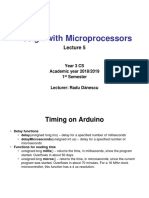Ir Pulse Generator Pseudocode
Ir Pulse Generator Pseudocode
Uploaded by
api-531773521Copyright:
Available Formats
Ir Pulse Generator Pseudocode
Ir Pulse Generator Pseudocode
Uploaded by
api-531773521Original Title
Copyright
Available Formats
Share this document
Did you find this document useful?
Is this content inappropriate?
Copyright:
Available Formats
Ir Pulse Generator Pseudocode
Ir Pulse Generator Pseudocode
Uploaded by
api-531773521Copyright:
Available Formats
//
module: IR pulse generator
// function: main
// initialize PIC32 hardware
// initialize and read the team select pin. This pin tells us which team we are on, to set
comms frequency
// set as digital input
// read pin value
// if we are team A, set pulse length to 300us. Otherwise set to 500us
// set up the ‘request data transfer’ pin, so we can initiate messages to the gameplay
node
// set as digital output
// call initialize the IR LED (see “LED_pin_setup” function below)
// initialize output compare hardware to generate IR pulses (see “IR_OC_HW_init” function
below)
// do not turn on the OC module (we only want to transmit when we are close to another
‘bot)
// initialize input capture hardware to capture IR pulses (see “IR_IC_HW_init” function
below)
// turn on IC module (we should always be looking for a signal)
// set up SPI communications
// upon command from game master node, begin IR transmission
// once hall sensor senses other ‘bot moving away (i.e., it has received the
message), terminate transmission
/*---------------------------- Module Functions ---------------------------*/
LED_pin_setup
// set as digital output
// set pin low to start
IR_OC_HW_init // uses OC1 and TMR3
// set pin as output compare
// map to correct peripheral
// disable output compare while setting up
// use single compare mode
// select timer 3
// set up timer:
// clear on bit
// select internal PBCLK
// set prescale
// load / clear timer register
// set the match value (to desired pulse length)
// set the period value (match to timer size for modulo arithmetic)
// set up interrupts
// clear interrupt flag
// set input capture priority
// turn on multiple interrupt vectors (MVEC)
// enable global interrupts
// enable local interrupt
Interrupt service routine for output compare:
__ISR(_OUTPUT_COMPARE_1_VECTOR, IPL6SOFT) IR_OC_Handler(void)
// clear flag
// increment transmission edge flag
// if we are in the ‘preamble’ portion of the message, set the timing to 1.5x
// else:
// if the transmission edge count is less than the number of edges we want to
transmit:
// set the timer for one period, to transmit the next edge
// else, we need to rest the edge count and transmit an end-of-message gap
// reset the transmission edge count
// set the timer for 8x period, to generate the pulse gap
IR_IC_HW_init
// set up interrupts
// clear interrupt flag
// set input capture priority
// turn on multiple interrupt vectors (MVEC)
// enable global interrupts
// enable local interrupt
// set up input capture pin as digital input and map peripheral
// set up timer (timer 2)
// pick correct IC setup:
// rising edge first
// capture every falling edge (inversion from comparator)
// interrupt on every capture
Interrupt service routine for input capture:
void __ISR(_INPUT_CAPTURE_2_VECTOR, IPL6SOFT) IR_IC_Handler(void)
// read buffer to clear it
// clear interrupt flag
// set a one-shot timer. This will reset the receiver_edge_count when we get the
pulse gap
// if we are *not* in active receiving mode, check that the period matches the
preamble period
// if it does:
// enter active receiving mode
// set the edge count to 1 - this is the first edge of the message
// otherwise:
// take no action
// if we are in active receiving
// calculate the period
// increment the receiver edge count
// capture the IC ticks for reference
IR_IC_one_shot_timer_init // This timer is used to check for a pulse-gap and reset
receiver edge count
// disable the timer (Timer 1) before configuring
// Choose the internal clock as the source
// set up the pre-scale so that the count fits into 16 bits
// set timeout to 1500us, because our signal will always be less than 1100us
// clear flag
// set up for multiple interrupt vectors
// enable global interrupts
// enable local interrupts
// configure priority and sub-priority
// clear any pending flag
// zero timer
// turn timer on
Interrupt service routine for one-shot (pulse gap) timer
__ISR(_TIMER_1_VECTOR, IPL6SOFT) IR_IC_OneShot_Handler
// clear flag
// when timer expires, the current edge number is the last baton value
// set last baton value variable to receiver edge count
// increment the baton number (for the next transmission)
// clear active receiving flag
// toggle “request for data” pin, to transmit baton value to game master note
// reset receiver edge count to zero
You might also like
- Copado Training Part 5 - Pipeline AutomationsDocument37 pagesCopado Training Part 5 - Pipeline Automationseduardoam12No ratings yet
- Lab0 CDocument5 pagesLab0 CJorge Cruz Mancilla100% (1)
- 1 Controlservice: Pseudo-Code For The Controlservice ModuleDocument2 pages1 Controlservice: Pseudo-Code For The Controlservice Moduleapi-360044869No ratings yet
- Flight ControllerDocument30 pagesFlight ControllerUsama FaisalNo ratings yet
- New Microsoft Word DocumentDocument22 pagesNew Microsoft Word DocumentUsama FaisalNo ratings yet
- H 1Document7 pagesH 1nilton_9365611No ratings yet
- Griet DSP ProgramsDocument14 pagesGriet DSP ProgramsJaipaul CheernamNo ratings yet
- Dron Controller Listing ProgramDocument3 pagesDron Controller Listing ProgramAl MtdrsNo ratings yet
- Ardu5 para S4ADocument6 pagesArdu5 para S4AEDWARD ENRIQUE ROJAS BARBOSANo ratings yet
- Tutorial 6 (External Interrupt)Document5 pagesTutorial 6 (External Interrupt)M.SadatNo ratings yet
- The Ultrasonic SensorDocument14 pagesThe Ultrasonic SensorAdalberto Sharpley100% (1)
- Fa20-Bee-150 MP Lab Report - 10Document6 pagesFa20-Bee-150 MP Lab Report - 10Saadat KhanNo ratings yet
- 3C Polling Vs Interrupts V1 2Document5 pages3C Polling Vs Interrupts V1 2veekaprogrammingNo ratings yet
- Balancebot CodeDocument8 pagesBalancebot CodeSam Fisher LambertNo ratings yet
- End Sem ExamDocument20 pagesEnd Sem Examdorejis472No ratings yet
- PID Position Control Dspic 30f2020Document4 pagesPID Position Control Dspic 30f2020FREEDOMHOUSE100% (3)
- Spi Protocol Verilog Code ExplanationDocument15 pagesSpi Protocol Verilog Code Explanationgokul pNo ratings yet
- 05 Arduino Sensors, Motors and External InterruptsDocument20 pages05 Arduino Sensors, Motors and External InterruptsMalik Adil Farooq100% (2)
- Interrupt ExerciseDocument2 pagesInterrupt ExerciseBerheNo ratings yet
- Pic C Sample Code Rs232Document3 pagesPic C Sample Code Rs232Med HilalismeNo ratings yet
- 1 Dogsm: Pseudo-Code For The Dogsm State MachineDocument3 pages1 Dogsm: Pseudo-Code For The Dogsm State Machineapi-360044869No ratings yet
- Chapter 7 and 8Document12 pagesChapter 7 and 8Amruta AvhaleNo ratings yet
- Arduino Starter KitDocument15 pagesArduino Starter Kitelektric2007No ratings yet
- Development Board For Stm8S003F3: by Nitin Chand M S (2018H1400171P), Rohith Krishnan P (2018H1400180P)Document13 pagesDevelopment Board For Stm8S003F3: by Nitin Chand M S (2018H1400171P), Rohith Krishnan P (2018H1400180P)Thông NguyễnNo ratings yet
- EeDocument12 pagesEepriyaNo ratings yet
- Design With Microprocessors: Year 3 CS Academic Year 2018/2019 1 Semester Lecturer: Radu D ĂnescuDocument23 pagesDesign With Microprocessors: Year 3 CS Academic Year 2018/2019 1 Semester Lecturer: Radu D ĂnescuAdrian BorcaNo ratings yet
- Sony Sirc ProtocolDocument10 pagesSony Sirc ProtocolFrancisco HernandezNo ratings yet
- Project DroneDocument10 pagesProject DroneJulius Ronaldo Betanov0% (1)
- 18f4550 Timer0 ExampleDocument2 pages18f4550 Timer0 ExampleHumberto RoddhuerNo ratings yet
- Code For Line FollowerDocument2 pagesCode For Line FollowerRaniel Gere GregorioNo ratings yet
- PIC C Command SummaryDocument14 pagesPIC C Command SummaryEdmond LamNo ratings yet
- Tech ME007 PDFDocument12 pagesTech ME007 PDFfredniels100% (2)
- Timer Interrupts: Here Arduino Due Forum PostDocument7 pagesTimer Interrupts: Here Arduino Due Forum PostAlbert DeluqueNo ratings yet
- Burst Mosfet AdvancedDocument2 pagesBurst Mosfet AdvancedumbiumbianNo ratings yet
- PR ControllerDocument6 pagesPR ControllerAnkit Chawla LCO17570No ratings yet
- Chapter 11 InterruptsDocument29 pagesChapter 11 InterruptsAnkit Kumar50% (2)
- ESD NPTEL SummaryDocument47 pagesESD NPTEL SummaryrahulpikaleNo ratings yet
- Memory Verification Using UVMDocument13 pagesMemory Verification Using UVMAnji medidiNo ratings yet
- PIDDocument4 pagesPIDIgnacioMartíNo ratings yet
- Wind SpeedDocument11 pagesWind SpeedNam Nguyễn HữuNo ratings yet
- ESD NPTEL SummaryDocument35 pagesESD NPTEL SummaryrahulpikaleNo ratings yet
- ELEC 3040/3050 Lab 4Document12 pagesELEC 3040/3050 Lab 4rktiwary256034No ratings yet
- A Precise Delay Method in Cortex-M KernelDocument11 pagesA Precise Delay Method in Cortex-M KernelzhangjifanNo ratings yet
- Embedded Real TimeDocument60 pagesEmbedded Real Timepraveen_kodgirwarNo ratings yet
- Arduino Code For Rev-LimiterDocument2 pagesArduino Code For Rev-Limiteryazzarco015No ratings yet
- ShortTest2-2016 SolutionDocument2 pagesShortTest2-2016 SolutionYash MaharajNo ratings yet
- Duplex Receiver LoRaDocument3 pagesDuplex Receiver LoRaKhalid KhalidNo ratings yet
- CodeDocument5 pagesCodeJerry LeeNo ratings yet
- Arduino Lab - COVID - 5301Document9 pagesArduino Lab - COVID - 5301Bing WangNo ratings yet
- Es&iomt Lab Manuval-12-14Document3 pagesEs&iomt Lab Manuval-12-1424ecet02No ratings yet
- Universal Asynchronous Receiver Transmitter-IT CAN WORKING AS A DUPLEX AND Full Duplex. in Uart Some Parameters Are Set by Users AreDocument6 pagesUniversal Asynchronous Receiver Transmitter-IT CAN WORKING AS A DUPLEX AND Full Duplex. in Uart Some Parameters Are Set by Users AreteekamNo ratings yet
- Unit VDocument25 pagesUnit Vsarthaksalunke9356No ratings yet
- 3pi-Linefollower - Demo Code For The Pololu 3pi RobotDocument9 pages3pi-Linefollower - Demo Code For The Pololu 3pi RobotRizal FebrianNo ratings yet
- Teste Codigo Automato ArduinoDocument15 pagesTeste Codigo Automato ArduinoCrhistian IzaguirryNo ratings yet
- Phase 1 Top: Note Guard - GuardDocument8 pagesPhase 1 Top: Note Guard - Guard2vijNo ratings yet
- Ecen90 Robot Arle HernandezDocument12 pagesEcen90 Robot Arle HernandezCenon Lumabad IIINo ratings yet
- Codigo Tacometro Led 22Document4 pagesCodigo Tacometro Led 22Roger Principe PernaleteNo ratings yet
- Timer/Counter: Timer 1 Below Are The Steps For Configuring and Using The Timer1 For Delay GenerationDocument9 pagesTimer/Counter: Timer 1 Below Are The Steps For Configuring and Using The Timer1 For Delay Generationvreddykumarreddy1No ratings yet
- Understanding Software Engineering Vol 3: Programming Basic Software Functionalities.From EverandUnderstanding Software Engineering Vol 3: Programming Basic Software Functionalities.No ratings yet
- CISCO PACKET TRACER LABS: Best practice of configuring or troubleshooting NetworkFrom EverandCISCO PACKET TRACER LABS: Best practice of configuring or troubleshooting NetworkNo ratings yet
- Video Game Asset Document SampleDocument31 pagesVideo Game Asset Document SamplePedro100% (1)
- Canteen Management SystemDocument14 pagesCanteen Management Systempradeep kumarNo ratings yet
- DLMS Client DrawingsDocument2 pagesDLMS Client Drawingskrkamaldevnlm4028No ratings yet
- Tele Immersion: Aman BabberDocument16 pagesTele Immersion: Aman Babberbabbar_amanNo ratings yet
- Microsoft Project Course Complete, 2013, 2016, & 2019 6 PDUs UdemyDocument1 pageMicrosoft Project Course Complete, 2013, 2016, & 2019 6 PDUs UdemyNavaneeth PurushothamanNo ratings yet
- Michelin Power Slick Ultimate UkDocument1 pageMichelin Power Slick Ultimate UkRaphael LabontéNo ratings yet
- NAVIPAC 3.10.5: Release NotesDocument4 pagesNAVIPAC 3.10.5: Release NotesR Fadhli100% (2)
- Brake Drum RefinishingDocument1 pageBrake Drum RefinishingY. VásquezNo ratings yet
- VPWS (Virtual Private Wire Service) - Part 1 - WWW - Ipcisco.com - WWW - IpciscoDocument7 pagesVPWS (Virtual Private Wire Service) - Part 1 - WWW - Ipcisco.com - WWW - IpciscoJesus RosalesNo ratings yet
- Chlor Alkali PDFDocument1 pageChlor Alkali PDFelham100% (1)
- Plan Vouchers 1 Dec 2021Document12 pagesPlan Vouchers 1 Dec 2021Annapurna MandalNo ratings yet
- Problemas de Bombas Centrifugas (Causas y Soluciones) InglesDocument118 pagesProblemas de Bombas Centrifugas (Causas y Soluciones) InglesGil ArandaNo ratings yet
- E01d0-Catalog Carrier - CompDocument4 pagesE01d0-Catalog Carrier - CompIrvan RamadhaniNo ratings yet
- LBB - What Does It Really Mean - JPVT - 2000Document9 pagesLBB - What Does It Really Mean - JPVT - 2000Fernando DiezNo ratings yet
- UntitledDocument4 pagesUntitledRAF RFNo ratings yet
- Assignment: Amazon Web ServiceDocument8 pagesAssignment: Amazon Web ServiceSyeda Subhana HashmiNo ratings yet
- Iso Iec TS 27034-5-1-2018Document84 pagesIso Iec TS 27034-5-1-2018Sadek SadNo ratings yet
- Algorithms Design and Analysis DP Sheet: Year 3 22 20 - Semester 2Document16 pagesAlgorithms Design and Analysis DP Sheet: Year 3 22 20 - Semester 2youssef amrNo ratings yet
- Contours and Contouring in Hydrography Part Ii - InterpolationDocument18 pagesContours and Contouring in Hydrography Part Ii - InterpolationShakiraNo ratings yet
- Lang TRDocument68 pagesLang TRevferrazNo ratings yet
- Traveloka Pay at Hotel Hotels Email SampleDocument14 pagesTraveloka Pay at Hotel Hotels Email SampleManasati ChannelNo ratings yet
- Cochrane Handbook For Systematic Reviews of Interventions 2019Document703 pagesCochrane Handbook For Systematic Reviews of Interventions 2019José Geraldo De Souza SilvaNo ratings yet
- ICTL Lesson Plan Year 2-Week 11Document5 pagesICTL Lesson Plan Year 2-Week 11gengkapakNo ratings yet
- Shreya Singhal Vs Union of India-2Document20 pagesShreya Singhal Vs Union of India-2Amit RoutNo ratings yet
- Steps in The Entrepreneurial ProcessDocument9 pagesSteps in The Entrepreneurial ProcessShafi SaheedNo ratings yet
- Astm B407 PDFDocument1 pageAstm B407 PDFgaminNo ratings yet
- HP Compaq Presario Cq40 Amd Uma - Compal La-4111p Jbl20 - Rev 0.4Document54 pagesHP Compaq Presario Cq40 Amd Uma - Compal La-4111p Jbl20 - Rev 0.4Migeru San50% (2)
- Charlie 2015 Malayalam DVDRip x264 AAC 5 1 ESubsMBRHDRGCharlie 2015 Malayalam DVDRip x264 AAC PDFDocument4 pagesCharlie 2015 Malayalam DVDRip x264 AAC 5 1 ESubsMBRHDRGCharlie 2015 Malayalam DVDRip x264 AAC PDFMarzelosNo ratings yet
- Touchless Touch Screen TechnologyDocument15 pagesTouchless Touch Screen TechnologyNitheshNo ratings yet

























































































